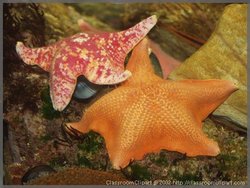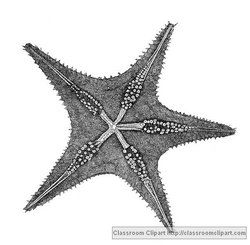Sea star
|
|
| Sea stars | ||||||
|---|---|---|---|---|---|---|
 Star Fish. Image provided by Classroom Clipart (http://classroomclipart.com) | ||||||
| Scientific classification | ||||||
| ||||||
| Orders | ||||||
|
many |
Sea stars or starfish are animals belonging to phylum Echinodermata, class Asteroidea. The names sea star and starfish are also used for the closely related brittle stars, which make up the class Ophiuroidea. They exhibit a superficially radial symmetry, typically with five or more "arms" protruding from a central body (pentaradial symmetry). In fact, their evolutionary ancestors are believed to have had bilateral symmetry, and sea stars do have some remnant of this body structure.
Sea stars do not have movable skeletons, but instead possess a hydraulic water vascular system. The water vascular system has many projections called tube feet, on the ventral face of the sea star's arms, which function in locomotion and feeding.
| Contents |
Digestion
Sea star digestion is carried out in two separate stomachs, the cardiac stomach and the pyloric stomach. The cardiac stomach, which is a sacklike stomach located at the center of the body may be everted - pushed out of the organism's body and used to engulf and digest food. Some species take advantage of the great endurance of their water vascular systems to open the shells of molluscs (clams, mussels and the like), and inject their stomachs into the shells. Once the stomach is inserted inside the shell it digests the mollusk in place. Because of this ability to digest food outside of its body, the sea star is able to hunt prey that are much larger than its mouth would otherwise allow (including mollusks, arthropods, and even small fish). Partially-digested food is passed to the inside of the sea star where digestion continues in the pyloric stomach. Due to all of this digestive demand, the sea star's arms are filled with digestive glands called pyloric caeca or hepatic caeca.External Anatomy
Sea stars are composed of a central disc with five arms exhibiting pentaradial symmetry. The mouth is located underneath (oral or ventral) the sea star, and the spiney surface covering the species is called the aboral or dorsal surface. On the aboral surface there is a structure called the madreporite which acts as a water filter and supplies their water vascular system with water to move (Gilbertson, 1999). Sea stars have a simple eye at the end of each arm. The eye is able to "see" only differences of light and dark; useful in detecting movement.

On the surface of the sea star surrounding the spines are small white objects known as pedicellariae. There consists thousands and thousands of these pedicellariae on the external body. Inside the sea star underneath all the hepatic caeca consist the gonads which are involved in reproduction. The radial canal which is across each arm of the sea star has what are called ampullae which surround the radial canal. The ampullae are teeth-like structures.
Sea stars are developmentally (embryologically) known as deuterostomes. Since echinoderms and chordates share this same embryological pattern, they are thought to be closely related. Nevertheless, as these creatures are invertebrates and not actually fish, most marine biologists are pushing to completely replace the term starfish with sea star.
Regeneration
Some species of sea stars have the ability to regenerate lost arms. When some sea stars are cut into pieces, each part that includes a portion of the central disk may grow into a whole other organism.
One genus particularly noted for its regeneration ability is Linckia, named for naturalist J.H. Linck. These sea stars can cast off an arm that regrows into an entire organism, as a means of asexual reproduction.
Geological history
Fossil sea stars (Asteroidea) have been found in rocks as old as the middle Ordovician period. Brittle stars (Ophiuroidea) are first recorded as fossils in rocks from the Carboniferous period. Complete fossil sea stars are very rare, but where they do occur they may be abundant. Most fossil sea stars consist of scattered individual plates or segments of arms. This is because the skeleton is not rigid, as in the case of echinoids (sea urchins), but is composed of many small plates (or ossicles) which quickly fall apart and are scattered after death and the decay of the soft parts of the creature. Scattered sea star ossicles are reasonably common in the Cretaceous Chalk Formation of England.
Three famous localities where complete fossil sea stars are found are the Devonian Bundenbach slates of Bundenbach in Germany, the Jurassic lithographic Solnhofen limestone of Solnhofen in Germany, and the Jurassic 'Sea star bed' of the Middle Lias formation near Bridport, Dorset in England.
See also
- Asterias
- Ophiuroidea (Brittle stars).
Clipart and Animal Pictures
- Clipart (https://classroomclipart.com/image/category/clipart.htm)
- Animal Clipart (https://classroomclipart.com/image/category/animal-clipart.htm)
- Animal Animated Clipart (https://classroomclipart.com/clipart/Animations/Animals.htm)
- Pictures of Animals (https://classroomclipart.com/image/category/animal-photos.htm)
- Amphibian Clip Art, Pictures and Photogaphs (https://classroomclipart.com/image/category/amphibian-clipart.htm)
- Farm Animal Clip Art, Pictures and Photographs (https://classroomclipart.com/image/category/farm-animal-clipart.htm)
- Mammal Clip Art, Pictures and Photographs (https://classroomclipart.com/image/category/mammal-clipart.htm)
- Marine Animal Clip Art, Pictures and Photographs (https://classroomclipart.com/image/category/marine-life-clipart.htm)
- Reptile Clip Art, Pictures and Photographs (https://classroomclipart.com/image/category/reptile-clipart.htm)
- Spider Clip Art, Pictures and Photographs (https://classroomclipart.com/image/category/spider-clipart.htm)
- Marine Animal Pictures (http://classroomclipart.com/cgi-bin/kids/imageFolio.cgi?direct=Animals/Marine_Life)
- Pictures of Starfish (http://classroomclipart.com/cgi-bin/kids/imageFolio.cgi?direct=Animals/Marine_Life/Starfish)
References
- Gilbertson, Lance; Zoology Lab Manuel; McGraw Hill Companies, New York; ISBN 0-07-237716-X (fourth edition, 1999)
- Solomon, E.P ., Berg, L.R., Martin, D.W. 2002. Biology Sixth Edition.


